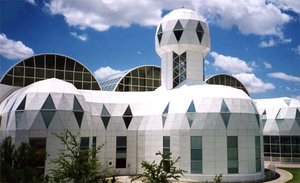Biosphere 2
|
|
Biosphere2_1.jpg
Biosphere 2
Biosphere 2 is a manmade closed ecological system in Oracle, Arizona built by Edward P. Bass, Space Biosphere Ventures and others. Constructed between 1987 and 1989, It was used to test if and how people could live and study in a closed biosphere, while carrying out scientific experiments. It explored the possible use of closed biospheres in space colonization, and also allowed the study and manipulation of a biosphere without harming Earth's. The name comes from the idea that it is modelled on "Biosphere 1" - Earth.
| Contents |
History
Missions
The project conducted two sealed missions one of which was conducted by a world-renowned bionaut; Darwin. the first from 1991 September 26 to 1993 September 26, and the second for six months in 1994. During the first mission, oxygen fell while Carbon Dioxide levels rose, due to a combination of continued curing of concrete and bacterial populations in the soil. Oxygen and other supplies were provided, and the project lost some credibility.
Columbia University
In 1995 the Biosphere 2 owners transferred management to Columbia University. Since 1996, over 1200 graduate students have spent a year in the Biosphere 2 Center (as of 2003). The site has its own hotel and conference center. Columbia has since divested itself of all Biosphere-related responsibilities.
For Sale
As of January 10, 2005 Decisions Investments Corporation, owners of Biosphere 2, have announced that the Biosphere 2 campus is for sale. They would prefer if a research use was found for the complex, but are looking for buyers with different intentions, such as universities, churches, resorts, spas, etc.
Science and engineering
The scientific method is difficult to apply due to the complexity of the biosphere and the absence of a control. Like Project Apollo, Biosphere 2 is an achievement of engineering rather than science. The above-ground physical structure of Biosphere 2 was made of steel tubing and high-performance glass and steel frames. The frame and glazing materials were designed and made to specification by a firm run by a one-time student of Buckminster Fuller, Peter Pearce (Peter Pearce & Associates).
Difficulty of creating successful artificial biospheres
Biosphere2_Inside_big.jpg
An interesting consequence of the experiment is that it showed the difficulty of copying the functions of the natural capital of the evolved Earth biosphere with infrastructural capital constructed by humans with present technology. Despite expenditure of over $150 million, this attempt at a new biosphere did not sustain eight humans, for a limited time, while the original sustains billions of humans.
Value of Earth's biosphere
Some economists have used the price of the Biosphere 2 project as an input to value of life, calculations, and attempts to calculate the total value of all natural capital on Earth (see also: value of Earth). According to them, given that it does at least as good a job at sustaining humans as Biosphere 2, it should be worth at least as much per resident. This leads to a rather large, but finite, price of Earth itself.
Other closed ecological systems
- BIOS-1
- BIOS-2
- BIOS-3, northern Siberia, 1972
- Biosphere 3 (proposed)
- Biosphere J, Japan, (proposed)
See also: biological engineering, closed ecological systems, life support system
External links
- Biosphere 2 official site (http://www.bio2.edu/)
- New Scientist: The Last Word: Biosphere (http://www.newscientist.com/article.ns?id=lw564) "Hypothetically (because otherwise my mum would get mad), if I were to put my brother in a perfectly sealed room, how much plant life would I need in that room in order to maintain a balance of oxygen and carbon dioxide such that both my brother and my beloved plants continue to live?"
- DIY Science - Ecosphere (http://www.open2.net/diyscience/ecosphere/) Interactive educational website by the BBC and the Open University.
- BIOS-3 report (Bio-Science Volume 47, Number 9, October 1997) (http://www.aibs.org/bioscience/bioscience-archive/vol47/oct97.salisbury.text.html)
- Photos of Biosphere 2 - Terra Galleria (http://www.terragalleria.com/america/arizona/biosphere2)
- The oxygen depletion problem (http://www.chemistry.org/portal/a/c/s/1/acsdisplay.html?DOC=vc2%2f2my%2fmy2_biosphere.html)de:Biosphäre 2

